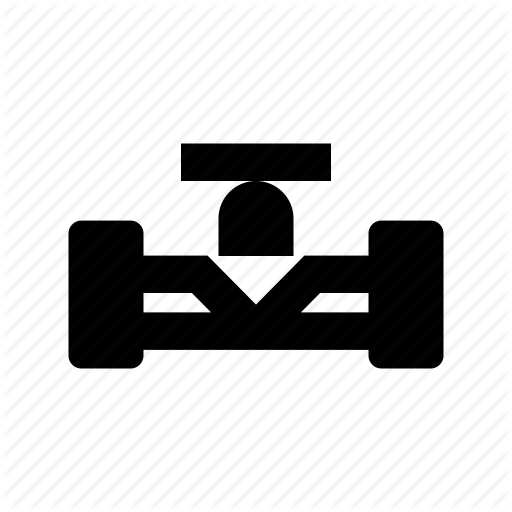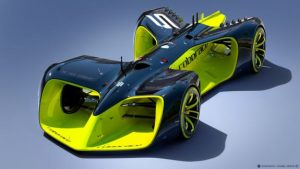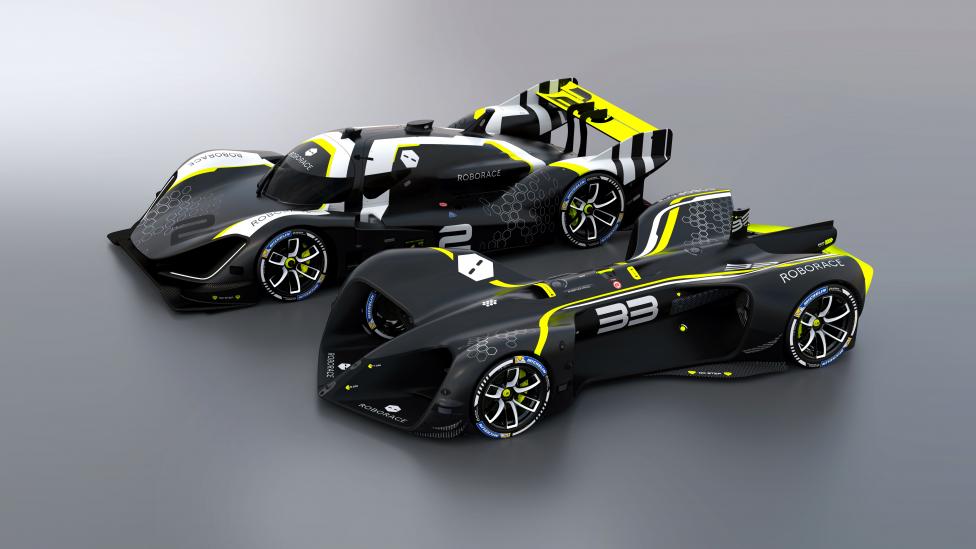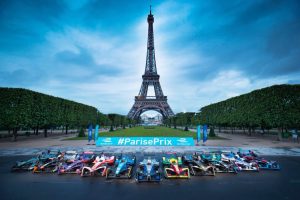What is Roborace ?
The Creators of Formula E have Announced a New Autonomous Series named ‘Roborace‘
Last year, the FIA introduced us to an all-new racing series in which all of the cars were powered entirely by electricity. Named Formula-E, the series saw cars reminiscent of Formula One or Indy Cars competing in exciting races through some of the world’s most prominent cities. After a successful first season, the creators of the event have now announced that they will launch a new motorsport series named ‘RoboRace’ that will run as part of Formula E.
| Category | Autonomous software-driven racing |
|---|---|
| Country | International |
| Folded | 2022 |
| Teams | 7 (2020–21) |
| Constructors | Daniel Simon |
| Chassis suppliers | Arrival |
| Tyre suppliers | Michelin |
Roborace was a competition with autonomously driving, electrically powered vehicles.[1] Founded in 2015 by Denis Sverdlov, it aimed to be the first global championship for autonomous cars.[2] From 2017 to 2019, the official CEO was 2016–17 Formula E champion, Lucas Di Grassi, who later became a member of Roborace’s supervisory board. The series tested their technology and race formats at FIA Formula E Championship events during 2016–2018.[3] In 2019 Roborace organized Season Alpha, which consisted of 4 trial racing events with several independent teams competing against each other for the first time. In 2020–21 Roborace held Season Beta with 7 competing teams. All teams utilized the same chassis and powertrain, but they had to develop their own real-time computing algorithms and artificial intelligence technologies.[3]
In May 2022, Arrival, the owner of Roborace, confirmed that they were no longer continuing the Roborace programme, but that they were hoping to find alternative funding.[4] In February 2024, after getting its stock delisted from the Nasdaq, Arrival's UK division entered administration, with future plans of a sale of Arrival and all of its affiliated assets.[5]
Cars
Robocar


The world's first purpose-built autonomous racing car, Robocar, was designed by Daniel Simon, who previously worked on vehicles for movies such as Tron: Legacy and Oblivion, as well as designing the livery for the 2011 HRT Formula One car.[6] Michelin is the official tyre supplier,[7] and the internal computing processors (Drive PX 2) are Nvidia.[8][9]
The chassis itself is shaped like a teardrop, improving aerodynamic efficiency. The car weighs around 1350 kg and is 4.8 metres (16 ft) long and 2 metres (6.6 ft) wide. It has four electric motors, each with a power of 135 kW producing over 500 hp combined, and utilizes a 840V battery.[10] For navigation, it relies on a mixture of optical systems, radars, lidars and ultrasonic sensors.[11] The vehicle has been demonstrated at speeds of almost 300 km/h (190 mph).[12]
DevBot

Development of the Robocar started in early 2016, with a first outing of a test vehicle, the so-called DevBot, following in the summer of the same year. The test car consisted of the same internal units (battery, motor, electronics) used in the Robocar, but were placed in the chassis of a Ginetta LMP3 car[13] without an engine cover in order to provide better cooling and access.
DevBot saw its first public outing at the Formula E pre-season tests in Donington Park in August 2016. After battery issues in Hong Kong caused the development team to abandon their demonstration run, the DevBot successfully drove twelve laps around the Moulay El Hassan Formula E circuit in Marrakesh.[14] Other test tracks included Michelin's testing ground in Ladoux and the Silverstone Stowe Circuit.
During testing ahead of the 2017 Buenos Aires ePrix, two DevBot cars raced against each other autonomously, resulting in one of the vehicles crashing on a corner.[15]
During the 2017–18 Formula E season, Roborace pitched pro-drifter Ryan Tuerck against a DevBot at the Rome ePrix.[16] At the Berlin ePrix, Roborace held the Human + Machine Challenge, the first race for combined teams of human drivers and AIs using a pair of Devbots.[17]
DevBot 2.0

An upgraded version of DevBot was announced in late 2018,[18] and after private testing made its public debut in 2019 at the inaugural Season Alpha event. DevBot 2.0 uses the same technology as both Robocar and DevBot, with the main changes being a conversion to being driven on the rear axle only, a lower position for the driver for safety reasons and a bespoke composite bodywork.
Seasons
Testing
2016–17 Formula E season
Roborace appeared at a number of Formula E events during the 2016–17 Formula E season. However, in this period only test drives with two different DevBots took place. Within the framework of the 2017 Buenos Aires ePrix both DevBot vehicles drove against each other on a race track for the first time. There were also DevBot demonstrations at the 2016 Marrakesh ePrix, 2017 Berlin ePrix, 2017 New York City ePrix and 2017 Montreal ePrix.
At the 2017 Paris ePrix, the developers also let a Robocar onto the track for the first time, even though the vehicle only drove the track at walking speed.
2017–18 Formula E season
At the start of the 2017/18 Formula E season, the Roborace developers once again tested the DevBot during a public time trial between the Roborace CI and the TV presenter Nicki Shields at the 2017 Hong Kong ePrix. As part of a similar time trial at the 2018 Rome ePrix, drift professional Ryan Tuerck also tested the DevBot.
The Human + Machine Challenge was created for the Formula E race on the Berlin ePrix. A team of doctoral students from the Technical University Munich[19] (TUM) and the University of Pisa programmed the software for the Devbot to drive autonomously around the circuit in Berlin. Afterwards both teams in combination with a human driver competed in a public time trial.[20] The vehicle of the team of the Technical University Munich finished the Human + Machine Challenge with an average lap time of 91.59 seconds, almost four seconds faster than that of the University of Pisa with 95.36 seconds and thus won the Challenge.[21]
At the Goodwood Festival of Speed, Robocar became the first ever fully autonomous race car to complete the Goodwood Hill Climb. The vehicle completed the first official autonomous run on 13 July 2018 within the framework of the event.[22]
Season Alpha (2019)
Season Alpha took place at various locations in Europe and North America with the aim of testing several competition formats using the new DevBot 2.0.[23] The first event was held at the Circuito Monteblanco in Spain, and featured the first race between two fully autonomous cars.[24] The events were not broadcast live, instead short clips on YouTube were released.[25] Two teams were competing: Arrival and Technical University of Munich.
On 7 July 2019, the Roborace DevBot 2.0 car set the first ever autonomous official timed run at Goodwood Festival of Speed, with a time of 66.96 s and a top speed of 162.8 km/h (101.2 mph). This is currently the record for autonomous vehicles.[26]
Roborace also set the Guinness World Record for having the fastest autonomous car in the world. The Robocar reached a speed of 282.42 km/h (175.49 mph).[27]
Season Beta (2020–21)
The second testing season took place at various locations between September 2020 and October 2021, featuring 16 races and involving mixed reality elements dubbed "Roborace Metaverse",[28] which is based on Roborace's patented technology.[29] The program of Season Beta competitions has gradually complicating rules arranged in a progression of so-called missions. Each mission consists of two racing rounds — one round per day. A mission plan issued by Roborace for each mission defines its objectives, rules, and point-scoring system. The key objective of Season Beta is to come to the point when the majority of competing teams have developed sufficient capability for wheel-to-wheel racing in Season 1.[30]
There were 7 teams competing in Season Beta: Arrival Racing (UK/Russia), Autonomous Racing Graz (Austria), MIT Driverless (United States), Acronis SIT (Switzerland), University of Pisa (Italy), PoliMOVE (Italy), CMU (United States).
References
- ^ "Introducing 'RoboRace' - a Motorsport with Zero Humans". www.sytner.co.uk. Retrieved 2017-10-06.
- ^ "Formula E is planning the first racing series for driverless cars". engadget.com. 28 November 2015.
- ^ a b "Formula E & Kinetik announce driverless support series". fiaformulae.com. 27 November 2015. Archived from the original on 2 February 2016. Retrieved 8 December 2015.
- ^ "Arrival writes off Roborace autonomous racing company". autocar.co.uk. 2022-05-19.
- ^ "Arrival: Electric van maker's UK arm enters administration". 2024-02-05. Retrieved 2024-02-06.
- ^ "HRT livery to be done by Daniel Simon". motorsport.com. 24 January 2011. Archived from the original on 3 January 2017. Retrieved 3 January 2017.
- ^ "Roborace stellt Michelin als Reifenpartner vor". e-formel.de. 16 December 2016.
- ^ "Go, Autonomous Speed Racer, Go! NVIDIA DRIVE PX 2 to Power World's First Robotic Motorsports Competition". blogs.nvidia.com. 5 April 2016.
- ^ Dow, Jameson (20 May 2017). "Roborace debuts their driverless "Robocar" on track at the Paris ePrix". Electrek. Retrieved 21 May 2017.
- ^ Burgess, Matt (2018-03-03). "Roborace is building a 300kph AI supercar – no driver required". Wired UK. ISSN 1357-0978. Retrieved 2019-05-31.
- ^ "Driverless Car makes History on the Streets of Paris" (PDF). Roborace. 20 May 2017. Archived from the original (PDF) on 2017-07-24.
- ^ "Formula E announces 300kph 'RoboRace' championship". Wired UK. wired.co.uk. 27 November 2015.
- ^ "Roborace DevBot debuts at Donington". current-e.com. 24 August 2016. Archived from the original on 4 January 2017. Retrieved 3 January 2017.
- ^ "Roborace: Erfolgreicher Test in Marrakesch". e-formel.de. 12 November 2016.
- ^ Kelion, Leo (20 February 2017). "Driverless Roborace car crashes at speed in Buenos Aires". BBC News. Retrieved 20 February 2017.
- ^ "Roborace's self-driving car isn't faster than a human (Yet)". 14 May 2018.
- ^ Gitlin, Jonathan M. (2018-10-16). "Roborace wants the future of racing to be AI plus humans, working together". Ars Technica. Retrieved 2019-05-31.
- ^ "The new DevBot 2.0 autonomous racer looks wild". Top Gear. 2018-11-09. Retrieved 2019-05-31.
- ^ Institute of Automotive Technology. "Research Group Vehicle Dynamics, Project Roborace: Autonomous Motorsport" (in German). Archived from the original on 2019-02-02. Retrieved 2019-01-30.
- ^ Laura Goudkamp, Bayerischer Rundfunk (2018-06-06). "Roboter-Rennauto vs. Mensch: Mit einem Algorithmus beim Roborace 2018 zum Sieg? | BR.de". Retrieved 2018-08-17.
- ^ "Fast and Driverless: Munich Roborace Victory |} NVIDIA Blog". The Official NVIDIA Blog. 2018-06-29. Retrieved 2018-08-17.
- ^ Matt Kew, James Newbold (2018-07-13). "Roborace car completes autonomous Goodwood hillclimb run". Autosport.com. Retrieved 2018-08-13.
- ^ jasoncartwright (2019-05-13). "Roborace's season alpha video will make you want to be a programmer". techAU. Retrieved 2019-05-31.
- ^ "First Roborace driverless car race held in Spain". motorsportmagazine.com. 2019-05-03.
- ^ "Season Alpha: Autonomous Racing Begins Here". YouTube. 2019-04-26.
- ^ Belton, Padraig (2019-08-27). "The robo racing cars accelerating driverless tech". BBC News. Retrieved 2020-06-29.
- ^ "Robocar: Watch the world's fastest autonomous car reach its record-breaking 282 km/h". Guinness World Records. 2019-10-17. Retrieved 2020-06-29.
- ^ "Roborace Returns To The Track With Revised Season Beta Competition Calendar". prunderground.com. 2020-07-22.
- ^ "A metaverse data fusion system". 2019-05-15.
- ^ "What is Season Beta?". medium.com. 2021-05-10.



